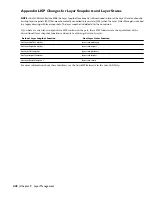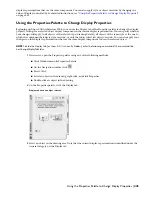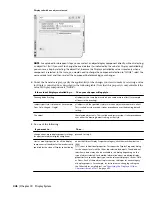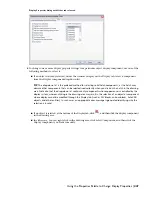
Display Sets Assigned to View Directions
You can identify the display set assigned to each view direction using the Display Manager. The Display Manager is a
utility for managing elements of the display system. The following illustration shows a drawing with two display
configurations, Medium Detail and Standard.
Sample display configurations in the Display Manager
In the Display Manager, the active viewport in the drawing (in bold type) is assigned the Medium Detail display
configuration. In the left pane, the display sets used are listed below the configuration name. An icon next to each
display set indicates the view direction to which the display set is applied. The Configuration tab in the right pane
shows the view direction to which each display set is mapped. In this example, the current view direction in the drawing
is Top, which uses the Plan display set. Objects in the active viewport are shown using the display representations in
the Plan display set.
If the view direction in the active viewport is changed to Front, the objects are shown using the display representations
in the Section_Elev display set. This is also true when the view direction in the active viewport is changed to Right,
Left, or Back.
The display set assigned to the Default view direction is used when any view direction other than the six orthogonal
views is selected, or when a view direction is not assigned a display set. If the view direction of the active viewport is
changed to Bottom, objects are shown using the display set assigned to the Default view direction—the Model display
set.
For more information about the Display Manager, see “
The Display Manager
” on page 457.
Displaying Objects in a Viewport
The display configuration, the current viewport, and the object interact in the following manner to determine what is
shown in a viewport:
■
The active viewport has a current view direction and a current display configuration. For example, the view direction
is Top, and the display configuration is Medium Detail.
■
The display configuration has one or more display sets and uses the display set that is assigned to the current view
direction. For example, in the Medium Detail display configuration, the Plan display set is assigned to the Top
view.
■
The display set has associated display representations and it selects the representation(s) associated with the object
that needs to be shown. For example, in the Plan display set, doors, windows, and walls use their Plan display
representations.
■
The object is shown in the active viewport using the appropriate display representation(s) and display properties.
Examples of View Directions That Use Different Display Sets
A display configuration assigns display sets to specific view directions. When a view direction is selected, the display
representations in the display set determine how each object is displayed in the viewport.
For example, the following illustration shows a viewport assigned the Plot display configuration and the Top view
direction. In this illustration, the objects are shown with a Plan display representation.
456 | Chapter 10 Display System
Summary of Contents for 00128-051462-9310 - AUTOCAD 2008 COMM UPG FRM 2005 DVD
Page 1: ...AutoCAD Architecture 2008 User s Guide 2007 ...
Page 4: ...1 2 3 4 5 6 7 8 9 10 ...
Page 40: ...xl Contents ...
Page 41: ...Workflow and User Interface 1 1 ...
Page 42: ...2 Chapter 1 Workflow and User Interface ...
Page 146: ...106 Chapter 3 Content Browser ...
Page 164: ...124 Chapter 4 Creating and Saving Drawings ...
Page 370: ...330 Chapter 6 Drawing Management ...
Page 440: ...400 Chapter 8 Drawing Compare ...
Page 528: ...488 Chapter 10 Display System ...
Page 540: ...500 Chapter 11 Style Manager ...
Page 612: ...572 Chapter 13 Content Creation Guidelines ...
Page 613: ...Conceptual Design 2 573 ...
Page 614: ...574 Chapter 14 Conceptual Design ...
Page 678: ...638 Chapter 16 ObjectViewer ...
Page 683: ...Designing with Architectural Objects 3 643 ...
Page 684: ...644 Chapter 18 Designing with Architectural Objects ...
Page 788: ...748 Chapter 18 Walls ...
Page 942: ...902 Chapter 19 Curtain Walls ...
Page 1042: ...1002 Chapter 21 AEC Polygons ...
Page 1052: ...Changing a door width 1012 Chapter 22 Doors ...
Page 1106: ...Changing a window width 1066 Chapter 23 Windows ...
Page 1172: ...1132 Chapter 24 Openings ...
Page 1226: ...Using grips to change the flight width of a spiral stair run 1186 Chapter 25 Stairs ...
Page 1368: ...Using the Angle grip to edit slab slope 1328 Chapter 28 Slabs and Roof Slabs ...
Page 1491: ...Design Utilities 4 1451 ...
Page 1492: ...1452 Chapter 30 Design Utilities ...
Page 1536: ...1496 Chapter 31 Layout Curves and Grids ...
Page 1564: ...1524 Chapter 32 Grids ...
Page 1611: ...Documentation 5 1571 ...
Page 1612: ...1572 Chapter 36 Documentation ...
Page 1706: ...Stretching a surface opening Moving a surface opening 1666 Chapter 36 Spaces ...
Page 1710: ...Offsetting the edge of a window opening on a freeform space surface 1670 Chapter 36 Spaces ...
Page 1956: ...1916 Chapter 42 Fields ...
Page 2035: ...Properties of a detail callout The Properties of a Callout Tool 1995 ...
Page 2060: ...2020 Chapter 45 Callouts ...
Page 2170: ...2130 Chapter 47 AEC Content and DesignCenter ...
Page 2171: ...Other Utilities 6 2131 ...
Page 2172: ...2132 Chapter 48 Other Utilities ...
Page 2182: ...2142 Chapter 51 Reference AEC Objects ...
Page 2212: ...2172 Chapter 52 Customizing and Adding New Content for Detail Components ...
Page 2217: ...AutoCAD Architecture 2008 Menus 54 2177 ...
Page 2226: ...2186 Chapter 54 AutoCAD Architecture 2008 Menus ...
Page 2268: ...2228 Index ...






























